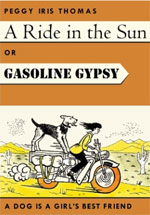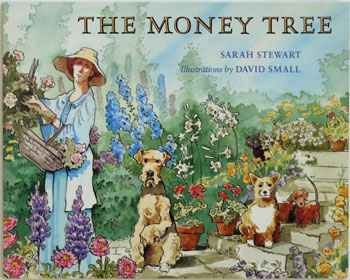My silent book club friends can rest assured I’m paying close and avid attention when I chair our meetings each month (and by “chair”, I mean simply introduce each reader and then sit back and enjoy the insights and delights each one has to share). But sometimes reader’s book summaries and comments will set my mind down interesting paths, as was the case here:
“In Finding the Mother Tree, ecologist Suzanne Simard explains her decades-long research on the relationships among trees in the forests of British Columbia. Simard shows that the long-held “competition” model of forest ecology is inaccurate, and that instead the major dynamic among plant life in forests is cooperation and interdependence. She has discovered that trees in a forest are interconnected — they communicate and share resources through a complex underground network of fungi.”
(summarized in ShortForm)
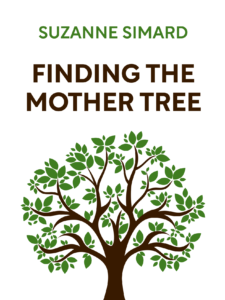 As wonderful in many ways as traditional book clubs (everyone reading and discussing the same book together) can be, this consideration of how trees may be interconnected immediately made me think of our silent book club orchard? copse? grove? differs from such groups in equally wonderful ways. Every month for close to six years now, I come away from every meeting and every scan of our combined reading list having learned, been nurtured, been challenged in good ways, had gates flung open, feeling throughout that my enrichment has been in concert with, not in competition with, my fellow readers.
As wonderful in many ways as traditional book clubs (everyone reading and discussing the same book together) can be, this consideration of how trees may be interconnected immediately made me think of our silent book club orchard? copse? grove? differs from such groups in equally wonderful ways. Every month for close to six years now, I come away from every meeting and every scan of our combined reading list having learned, been nurtured, been challenged in good ways, had gates flung open, feeling throughout that my enrichment has been in concert with, not in competition with, my fellow readers.
Those I’ve spoken to about joining or starting their own silent book club groups often mention disenchantment with traditional book clubs that does sound like perverse forms of competition: that certain members always get to take the lead in selecting the reading, that getting through the reading is sometimes an unpleasant endurance race, that some readers’ interpretations of the assigned reading “wins” over others’. No, not all single book clubs are like that, but the complaints are a recurring theme that you won’t find with silent book club groups.
So as not to get too proud of how great a silent book club group can be … well, that such a group’s nurturing and “biodiversity” can be described with an analogy related to fungi will surely keep us all humble.
The question that kicked off this month’s themed discussion meeting was:
Do you keep track of your reading? If so, do you use a journal, spreadsheet, Goodreads or something else? If not, why not? Do you also keep track of recommendations / what you plan to read next?
Our conversation touched on lots of great ideas and options, including:
- Handwritten journals or log books (I’ve written previously about my precious Book of Books.)
- Goodreads
- Evernote
- Bookly
- Kindle samples
- Library recommendations and themes (see more below)
- Read Harder / Book Riot and other reading challenges

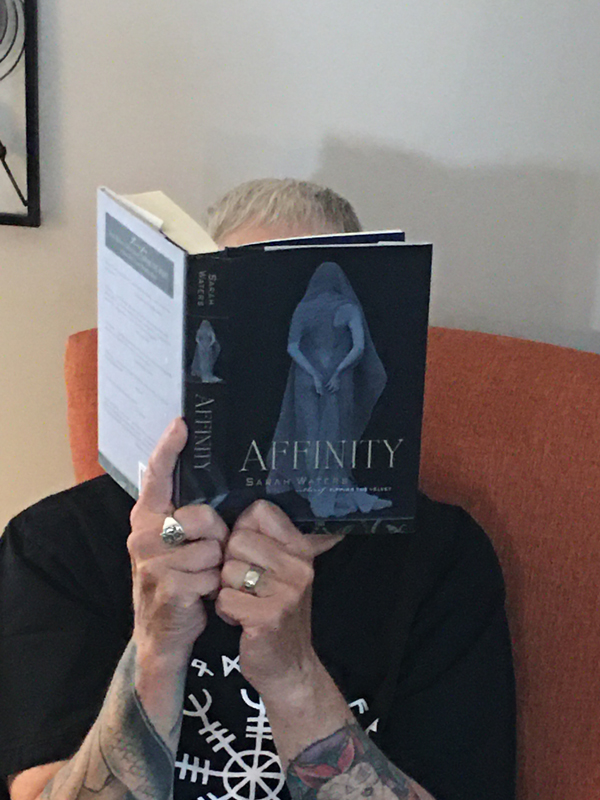
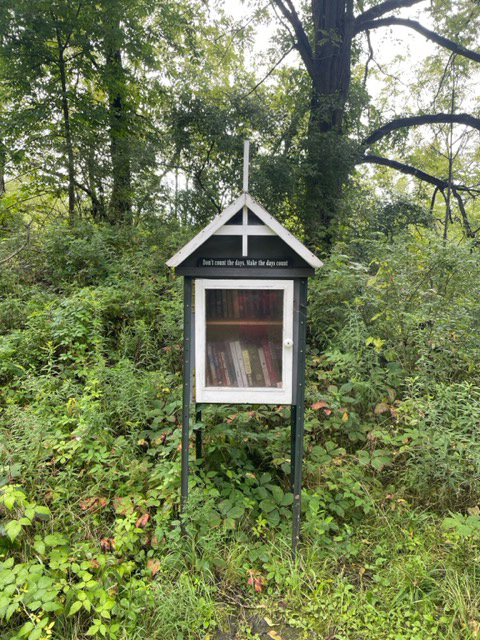

Here is our group’s latest combined book list (it’s breathtaking!), gathering up books mentioned and discussed at our end of August meeting. Each list reflects the reading of many of our members. Many provide their reading lists even when they can’t attend a meeting. The titles featured in each of our reports encompass print and digital versions of books, along with audiobooks.
Any title on any of our group’s lists means that at least one (but often more) readers have given that title some consideration. That’s encouragement for you and other readers checking out our reports and lists to consider it, too. Is that a recommendation? It might be, but not exactly or necessarily. Inclusion on this list always means that a title has been given thoughtful consideration and attention by our readers, which counts for a lot.
- Snacking Cakes: Simple Treats for Anytime Cravings by Yossy Arefi
(the Powdered Donut Cake on page 93 was excellent, reports the contributing reader!) - Purge Fluid by Ivy Allsop
- All the Things I Lost in the Flood by Laurie Anderson
- Masala Lab: The Science of Indian Cooking by Krish Ashok
- Shrines of Gaiety by Kate Atkinson
- The Whispers by Ashley Audrain
- Indie Rock by Joe Bishop
- Who is your mercy contact? by Ronna Bloom
- The Heart’s Invisible Furies by John Boyne
- Permission to Feel – Unlocking the Power of Emotions to Help Our Kids, Ourselves, and Our Society Thrive by Marc Brackett
- Four Thousand Weeks: Time Management for Mortals by Oliver Burkeman
- Breaking Up With Sugar – A plan to divorce the diets, drop the pounds, and live your best life by Molly Carmel
- Autobiography of Red by Anne Carson, narrated by Paul Boehmer (audiobook)
- Cursed Bunny: Stories by Bora Chung
- Cincinnati Review (Spring 2023)
- Happy All the Time by Laurie Colwin
- Wilful Blindness: How a Criminal Network of Narcos, Tycoons, and CCP Agents Infiltrated the West by Sam Cooper
- Sweetland by Michael Crummey, narrated by John Lee (audiobook)
- The Librarianist by Patrick de Witt
- Hunting by Stars by Cherie Dimaline, narrated by Meegwun Fairbrother, Michelle St. John (audiobook)
- Strangers in the Night by Heather Dobbs
- Trouble by Amanda Earl
- Emptying the Ocean by Kim Fahner
- The Sign for Home by Blair Fell
- I Only Read Murder by Ian Ferguson & Will Ferguson, narrated by Molly Secours (audiobook)
- Jemima Shore – a series by Antonia Fraser
- Khabaar – An Immigrant Journey of Food, Memory, and Family by Madhushree Ghosh
- Theatre of Fish – Travels through Newfoundland and Labrador by John Gimlette
- Travelling In, Travelling Out – A Book of Unexpected Journeys by Namita Gokhale, Mishi Saran
- Monitoring Station by Sonja Ruth Greckol
- Xanax Cowboy by Hannah Green
- The Janus Stone by Elly Griffiths
- Digitesque series by Guerric Haché
- Fourth Under Sol by Guerric Haché
- The Art of Plumbing by Brecken Hancock
- An American Sunrise by Joy Harjo (audiobook)
- Local Interest by Emily Hasler
- The Built Environment by Emily Hasler
- Really Good, Actually by Monica Heisey, narrated by Julia Whelan (audiobook)
- Scarborough by Catherine Hernandez
- Among the Untamed by dee Hobsbawn-Smith
- The Ruling Clawss: The Socialist Cartoons of Syd Hoff by Syd Hoff
- Message in a Bottle – Ocean dispatches from a seabird biologist by Holly Hogan (audiobook)
- Open Throat by Henry Hoke
- Eleanor Oliphant is Completely Fine by Gail Honeyman, narrated by Cathleen McCarron (audiobook)
- The Half Known Life: In Search of Paradise by Pico Iyer
- The Summer Book by Tove Janssen
- The Book of Job
- Quarrels by Eve Joseph
- Demon Copperhead by Barbara Kingsolver
- I was Never Here: My True Canadian Spy Story of Coffees, Code Names, and Covert Operations in the Age of Terrorism by Andrew Kirsch
- Cosmic Horror by James Knight
- The Road to Lichfield by Penelope Lively
- What We Talk About When We Talk About Dumplings, edited by John Lorinc
- Shadow Blight by Annick MacAskill
- All Our Wrong Todays by Elan Mastai
- On Reading by Steve McCurry
- 1979 by Val McDermid, narrated by Katie Leung (audiobook)
- Dreams and Journeys by Frederick McDonald
- The Ruin by Dervla McTiernan
- The Song of Achilles by Madeline Miller
- These Violent Delights by Micah Nemerever
- When We Lost Our Heads by Heather O’Neill
- Thursday Murder Club series by Richard Osman
- The Bullet That Missed by Richard Osman, narrated by Fiona Shaw (audiobook)
- Keith Haring: The Story of His Life by Paolo Parisi
- Tom Lake by Ann Patchett, narrated by Meryl Streep (audiobook)
- Take My Hand by Dolen Perkins-Valdez, narrated by Lauren J. Daggett (audiobook)
- The Pet Radish, Shrunken by Pearl Pirie
- Jackaby by William Ritter
- Boat by Lisa Robertson
- Standing in the Shadows by Peter Robinson
- The Lost Ticket by Freya Sampson
- A Swim in a Pond in the Rain – In which four Russians give a master class on writing, reading, and life by George Saunders
- Selvage by Kate Siklosi
- Finding the Mother Tree – Discovering the wisdom of the forest by Suzanne Simard (audiobook)
- Summer by Ali Smith
- A Tree Grows in Brooklyn by Betty Smith, narrated by Kate Burton (audiobook)
- Some States by Tom Snarsky
- After the Rapture by Nancy Stohlman
- The Marigold by Andrew F. Sullivan
- A Certain Hunger by Chelsea G. Summers
- Beasts of the Sea by Kate Sutherland
- Cluster by Souvankham Thammavongsa
- Congratulations, the best is over! Essays by Eric R. Thomas (audiobook)
- The Rabbit Factor by Antti Tuomainen
- There’s More by Uchechukwu Peter Umezurike
- Remarkably Bright Creatures by Shelby Van Pelt
- Time is a Mother by Ocean Vuong (audiobook)
- Affinity by Sarah Waters
- Project Hail Mary by Andy Weir
- This is Happiness by Niall Williams
Here are some extra book-related articles, resources, news and recommendations. These items and tidbits are often companions to books on the list, or are inspired or offered by our members and/or come up during our discussions and chat.
- Blended in to our combined reading list this month is one reader’s (er, my) list of Sealey Challenge selections – a challenge to read 31 poetry works in the 31 days of August – completed so far. When the challenge is over, I’ll post that list separately, in the order in which the works were read.
- The SciFri Book Club, from Science Friday
- Gamify Your Reading With This Readathon Board Game! (from Book Riot)
- Books & Boba – An Asian American Book Club & Podcast – Books & Boba is a book club and podcast dedicated to spotlighting books written by authors of Asian descent. Every month, hosts Marvin Yueh and Reera Yoo pick a book by an Asian or Asian American author to read and discuss on the podcast. In addition to book discussions, they also interview authors and cover publishing news, including book deals and new releases.
- 2022 Recipients of The Dragon Award – The award is described as following: “In a world of the ordinary, the Dragon is most astonishing. Its heart burns with determination and desire as it soars from page to canvas to screen. The Dragon’s inner fire elevates it above the mundane, and once released, inspires respect and awe from all who witness its greatness.”
- Manga of the Month, from Reverse Thieves, a site that delves deep into character- and story-focused analysis of anime and manga, and sometimes look at the fandoms that surround those hobbies as well.
- Hip-Hop Books for Adults from The New York Public Library – As part of hip-hop’s 50 year anniversary,NYPL’s recommended reads for all ages that explore the influence and impact of hip-hop, including memoirs by landmark artists, explorations of fashion, fiction inspired by hip-hop culture, and more
Our previous reports and book lists are always available right here, growing every month.
You can also check out links to articles, interviews and more here – some with San Francisco-based Silent Book Club founders Guinevere de La Mare and Laura Gluhanich, and some with us here in east end Toronto.
Learn more about silent book clubs via Guinevere and Laura’s Silent Book Club web site. You can find information on meetings happening around the world and close to where you live. Every club is a different size, format (in-person, virtual or combinations) and vibe, so contact a club’s organizers beforehand if you have any questions or preferences. Please feel free to contact me for more information about our club and its offerings.
Wishing you and the grove of readers around you – in person and virtually – all the literary sunshine, shade, precipitation and nutrition you need to thrive!

